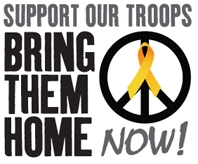 You say you'll change the Constitution
You say you'll change the Constitution
Well, you know
We all want to change your head
You tell me it's the institution
Well, you know
You better free you mind instead
--Revolution, The Beatles________
Considering Sgt. Hester's Silver Star award recently put me in mind to review the action for which it was awarded. It shows both the extreme professionalism of the National Guard at the squad level, yet the the incredible incompetence at the staff planning and task organization level required of higher headquarters.
There are several violations of tried and true principles in play here. Sgt. Hester was part of SSG Timothy Nein's MP team on patrol 3/03/05, when a "convoy of 30 civilian tractor trailers and their small military escort were ambushed about 26 miles southeast of Baghdad."
"SSG Nein and his team were familiar with the area. They had been leading patrols up and down a 25-mile section of the highway for months, looking for ambush sites and roadside bombs.
"After each trip, Nein would review with his troops what they did right, what went wrong and how they could do better. They had been attacked on the highway several times and repelled each one."
"Nein insisted his team study the routes, maps and terrain for every mission. The squad did thorough maintenance checks after each one.
"His soldiers made sure to store arms, ammunition and equipment in the
same place and same way for each of their Humvees.
"He wanted everything dress right dress," said Sgt. Jason Mike, a medic in Nein's squad who was involved in the Palm Sunday Ambush. "From the water setup to the ammo to the smoke grenades and grease bins, everything had to be exactly thesame, so that if you ended up in another vehicle you knew where everything was."
"They knew where potential ambush sites resided and discussed what they would do if attacked — whether to counterattack, retreat, stay in the vehicle or get out ("Yes, Nein Killed the Ambush").
Clearly this NG squad was properly trained and was both technically and tactically proficient. It is safe to assume that this fact is a reflection of the leadership climate of the entire 617th Military Police Company of Kentucky's NG.
But Ranger is lost after this:
"When Nein surveyed the battlefield that day, he realized the attack was much larger and more sophisticated than expected. He radioed for close air support, but it wouldn't arrive until the battle's end."
Clearly the MP's were crackerjack troops and performed flawlessly, but where was higher HQ planning evident in this firefight? It was only "by coincidence, another equally large convoy was heading north, with 24 soldiers, and met with the southbound convoy at the point where terrorists readied to attack," allowing for the successful action orchestrated by SSG Nein.
Battles and wars are not won by coincidence, but staff planning and coordination. Fights are simply reflections of this prior coordination. Staff weinies plan and Captains and lower fight the battle.
Why was there no armed air support for two convoys of approximately 60 civilian contractor tractor trailers? This is a significant number of assets that need more than "coincidental" happy linkup of three friendly units. There is no unity of command among these three units, no synergy, as there would be had there been infantry units under one command in the area.
Bear in mind, MP's are not combat assets. Division, Corps, theatre MP's used to have a rear area protection function, and were trained and equipped to fight limited actions -- but, they are not combat assets. Using MP's as such is a misapplication of these units. They can engage in firefights, but they are not battle assets.
"[SSG Nein's 10 members of Kentucky's 617 MP Company] were conducting a routine patrol in three Humvees when they approached the [first] convoy, escorted by nine soldiers in three other Humvees from the 623rd Field Artillery Regiment, also from Kentucky."
Why is a Field Artillery Regiment conducting convoy escort? When and why did FA units turn into road guards? More appropriately, SSG Nein's MP unit should have been escorting the convoy, with FA available to bring fire support on call.
The best military utilization of the FA assets is manning their guns and providing on-call preplanned fires on the area. After all, SSG Nein clearly states that they were familiar with the route and knew the possible ambush sites.
If so, why were there no preplanned artillery concentrations planned along the route? Why no air cover? What higher HQ operations officer would ignore these basic everyday combat planning considerations?
The concept of rear area protection would apply perfectly to this scenario. The fact that 50 enemy fighters were present should not be devastating event. This should be simply a minor inconvenience to a combined arms team with proper support. An army/USMC rifle platoon with 60/81 mm mortar support would mince an enemy element of this level. So why throw a piecemeal coincidental alliance of small units into the fray?
If this incident is typical of the day-to-day operations in Iran and Afghanistan, then it is no wonder that casualties are higher than they should be. The soldiers at squad level showed wonderful esprit and panache, but there was apparently little or no staff planning or contingency planning beyond throwing the MP's into the breech.
Heroism is not a substitute for correct planning and unit utilization.
Labels: helter skelter, hester silver star, palm sunday ambush, sgt. nein
 You say you'll change the Constitution
You say you'll change the Constitution










7 Comments:
i will never be one to discount the role of luck and happenstance in conflict. but i also know that hope is not strategy. over and over in planning sessions i was the voice that said, "great plan commander, what are we supposed to do if they decide to shoot back?" to have these convoys driving around at top speed without coordination and the covers of artillery and air that you masterfully deliniated is beyond insanity. it is bog simple stupid.
MB,
Yes, it amounts to what you said yesterday--it is all whack-a-mole, and everyone is mistaking motion for progress.
There are some bog simple rules in the Army: the infantry fights the ground combat, the armor attacks deep objectives in the enemy's rear, and artillery supports them with fire. And of course this is not a war, so those time-honored rules are not being applied.
It even seems that staff planning guidelines and actions are being ignored because of reliance on contractors who are outside of the military chain of command.
It is criminal to send any element out as road guards that do not have access to immediate reaction forces and direct support artillery and on-station gunships.
If we are not using these assets, why in the hell do we have them in the inventory?
In the rear battle concept of the air-land battle, corps and theatre artillery assets would fire concentrations into friendly areas to neutralize enemy penetrations. This battle was not coordinated through the RAYOC concept(Rear Area Operations Center).
A 30-year-old concept like this would work well in Iraq. This firefight showed a complete lack of staff coordination, which is unforgiveable. Once again, the troops save the bacon.
among the most effective operations i participated in were the ones where we would slink along the trail and pinpoint targets for the air guys to pound. if we were actually going to seek contact we always, always made sure the gunships and the big bore stuff was standing by with their caps on straight. our artillery was one thing that the enemy never came up with a countermeasure or adequate defense for. sure they could go into the tunnels but what the hell kind of tactical advantage was that? that we have whole companies stuck out on isolated islands in a sea of hostile populations without having air cover and artillery dialed in is beyond stupid. it should be a crime to be that idiotic.
MB,
Roger that. We've always proposed that the U.S. military is become nothing but the Iraqi police forces, and has no relationship to the realities of classic ground combat.
If the infantry could at least employ their organic mortars there would be some benefit to the engaged troops.
Everything in this war seems to be criminal, and the U.S. military are the victims.
Everything that you've described is utilizing all assets as a force multiplier, and is sound both tactically and strategically. This outlined method is the only way to achieve a kill ratio that is acceptable in a COIN situation. Anything less is a brawl.
Man oh man, have you got that right.
I figured out long ago that the Army Lost Its Fucking Mind (r) during the GWOT.
We have pogue units out there doing Cavalry and Infantry jobs, and 90% of the problem isn't with the line troops who do the patrol, it is with the battalion staff who are too LAZY, busy, and disinterested to exert any force on the battlefield.
I was 11B active, and now 13B guard. My SP Howitzer unit went to Ramadi in 05-06, and while the NCOs (most) and joes (most) were plenty up to the task (patroling, fob defense, and some arty), the BN staff couldn't see past the administrative requirements. We had to do x convoys, man y OPs, check and check. Concertina for position improvement? Preplanned fires? Any tactical thinking? Actively pursue the enemy? Nope, they were too busy playing solitaire in the TOC to give any thought to more than the simple requirement. Battle tracking? LOL!
Put the pogues back in their pogue jobs, make more Cavalry and Infantry instead of pretending like all units are the same.
How the heck do you protect 30 semis with 4 gun trucks, REALLY?
Jamie,
Thanks for your comment.
Welcome.
jim
Jamie,
How did you specifically come to find this article after 4 years ?
I'm just curious how and why you ended up on this essay.
jim
Post a Comment
<< Home